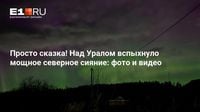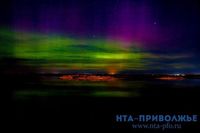On the night of April 16 to April 17, 2025, the Earth found itself at the epicenter of a spectacular cosmic event as it entered a coronal mass ejection from a solar protuberance, significantly improving the geomagnetic conditions. This astronomical phenomenon allowed for the stunning display of the aurora borealis, captivating observers across various regions, particularly in the north and northeast of the Komi region, and even extending to areas much further south.
The excitement began on April 15, when our planet was enveloped in a cloud of solar matter, leading to unstable cosmic parameters the previous night. Despite the challenges posed by moonlight, the aurora remained bright and beautiful in the middle latitudes. As the situation stabilized, the formation and observation of the aurora became more consistent, indicating that we were indeed in the heart of the coronal mass ejection. With solar wind speeds reaching approximately 500 kilometers per second, there was potential for a strong magnetic storm, contingent on the stability of the phenomenon persisting for several hours.
In the Sverdlovsk region, the northern lights reached one of their maximum levels, as reported by Vladilen Sanakoev, an astronomer at the UrFU observatory. He noted that the glow was particularly intense, showcasing the power of solar activity. The aurora borealis, which is typically caused by magnetic storms resulting from increased solar activity, was visible over a wide area, delighting residents and astronomers alike. The speed of the charged particles emitted during solar flares can reach up to 400 kilometers per second, allowing them to penetrate the Earth's magnetic field, which usually protects life from such strong solar emissions.
In Nizhny Novgorod, residents were also treated to the breathtaking sight of the northern lights on the evening of April 16. Many took to the Volga embankment to witness the celestial display, and social media quickly filled with images from the Chkalovsky district, Balakhna, and Varnavino. According to the Laboratory of Solar Astronomy of the IKI RAS, the magnetic storm that preceded this event had reached a level of G3.3 on the NOAA scale, indicating strong geomagnetic activity.
As the auroras dazzled spectators, the science behind these phenomena continued to intrigue many. The northern lights occur when charged particles from the Sun collide with the Earth's upper atmosphere at incredible speeds, resulting in the stunning visual effects that can be seen in the polar regions and sometimes even further south. The colors of the auroras, ranging from green to pink and violet, depend on the type of gas particles involved and their altitude in the atmosphere.
In the days leading up to this celestial spectacle, there was a palpable sense of anticipation among astronomers and skywatchers. The potential for strong magnetic storms had been on the radar, and as the conditions aligned, enthusiasts were ready with cameras in hand to capture the moment.
Reports from various regions highlighted the widespread visibility of the northern lights. In the Komi region, the skies were particularly vibrant, showcasing the beauty of nature's light show. Observers described the experience as magical, with some noting how the auroras seemed to dance across the sky, creating a surreal atmosphere.
As the phenomenon unfolded, it became clear that the auroras were not just a local event but a spectacle that could be enjoyed by many across the country. Residents in cities like Yekaterinburg were also expected to get a glimpse of the lights, with astronomers advising them to look northward as the clouds began to clear.
Many families in Yekaterinburg gathered together, eagerly awaiting the chance to witness the auroras, often accompanied by their pets. The sense of community and shared wonder added to the magic of the event, as people came together to appreciate the beauty of the natural world.
As the night progressed, the auroras continued to captivate audiences, with images and videos circulating on social media platforms. The phenomenon provided a welcome distraction from the daily grind, reminding everyone of the wonders of the universe and the incredible forces at play just beyond our atmosphere.
In conclusion, the northern lights of April 16-17, 2025, were not just a stunning visual display but a reminder of the complex interactions between the Earth and the Sun. As scientists continue to study these events, the public's fascination with the auroras serves as a testament to our enduring curiosity about the cosmos.








